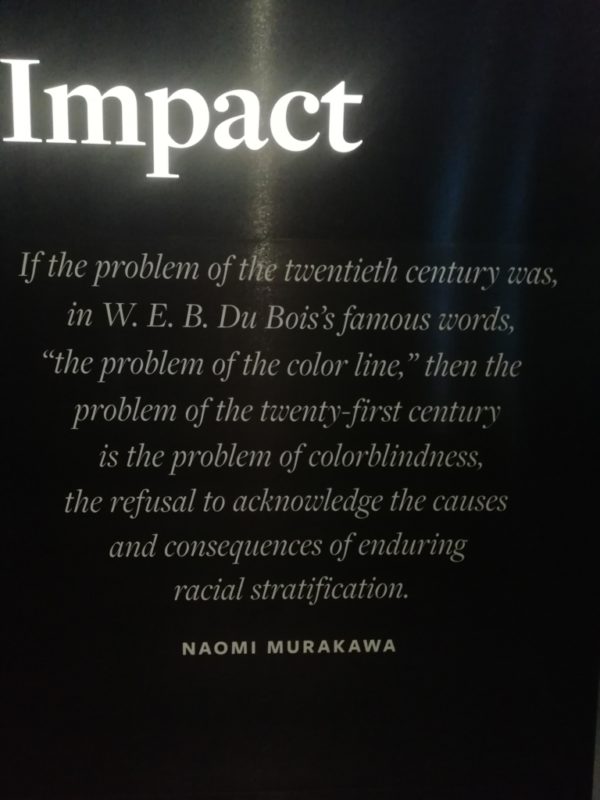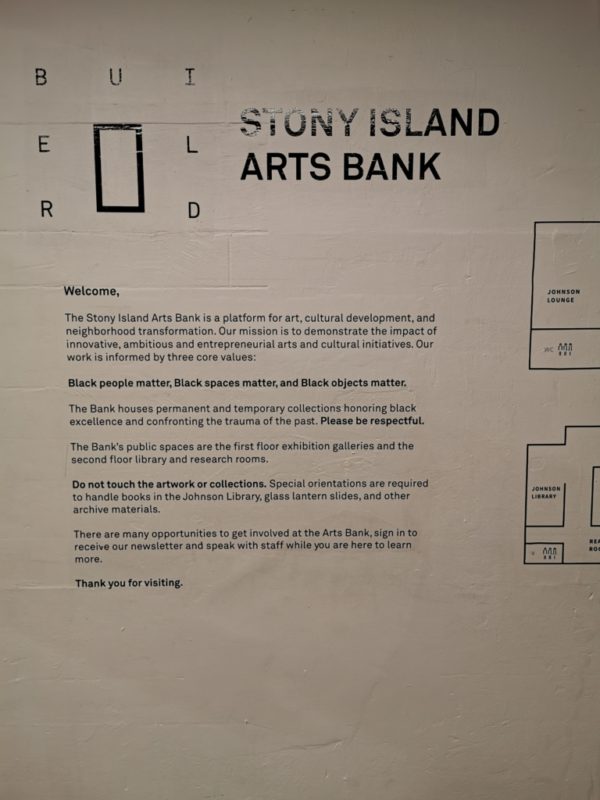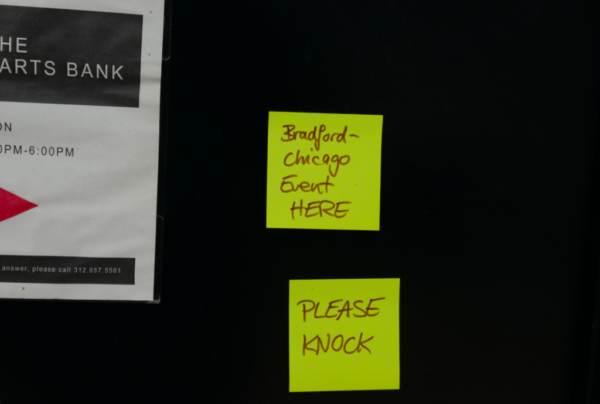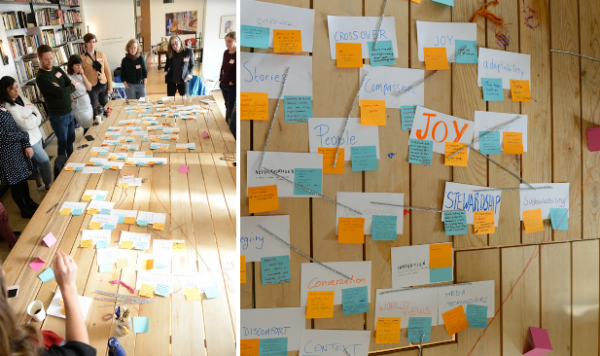U.S. dialogues
A group of us – staff, researchers and collaborators from Bradford – went to Chicago and Washington D.C. to explore innovative participatory and place-based practice. The experience was transformative, both for many of us personally and for the Bradford’s National Museum research. The trip enabled race and racism to become properly foregrounded in our work and led to a significant process – led by the staff action research group – of reading, self-education and collective reflection.
In November 2019 a group of us connected to the Bradford’s National Museum project went to Chicago and Washington DC. with the aim of exploring cutting-edge participatory, co-creative and community engagement work as well as the role of national organisations in their local places.
While we recognise Chicago, Washington D.C. and Bradford have many differences, we were also interested in their commonalities in terms of the need to proactively address racism, develop cross-community conversations and deal with urban regeneration in ways which engage existing communities, resist gentrification, and build community wealth.

The Chicago workshop focused on ethos, practices and structures. Image credit: Erik Petersen
In Chicago we were motivated by understanding the histories of community organising and community participation as well as the work that is happening in the city now. We collaborated with Elory Rozner (Uncommon Classrooms) to contact organisations that had demonstrated a commitment to innovative community convening through the arts and sciences and ran a workshop at Stoney Island Arts Bank (Word Document).
In Washington D.C. we exchanged ideas with the Smithsonian Institution and visited The American Folklife Center at the Library of Congress to explore specific issues facing national museums, libraries and archives aiming to do place-based work in their local area.
My main hope for the trip was that it would allow us as a group to experience with all our senses socially-engaged, courageous and openly political arts and heritage practice in a different context to ours.
While we were in the US, I couldn’t tell whether what I had hoped, was working. We had lots of conversations, but I wasn’t sure yet what they were doing for our learning. How far were we able as a group to move from looking for techniques to copy into our practice and rhetoric, to discussing the core logics of what we do? How much were we be able to have difficult open conversations, for example about power and race and how our own individual practices related to those?
My favourite moments happened after the trip and haven’t stopped since. Since the trip museum staff we travelled with delved into learning more about systemic racism in our own UK contexts and museum sector. For the Science and Media Museum to be able to be open, collaborative and locally rooted, being able to understand and speak to the issue of racism is an indispensable quality.
Julia Ankenbrand, Project Researcher
A memorable moment for me was visiting Stony Island Arts Bank for the first time and just experiencing the incredible power of that space. Seeing for example the Johnson Publishing Library – the sheer volume of books connected to Black culture and politics collected together in one place, was an important moment for me. I felt the power and significance of having a specific space – not just any space but an incredibly beautiful space – that is wholly owned and run by artists of colour.
Being there I could feel the huge value that having a place designed by and specifically for people of colour could have in Bradford. There were other venues I visited that reinforced the importance of this sense of community ownership. One was a music and performance space for young people, The Promontory in the Hyde Park neighbourhood of Chicago. Another was the famous poetry café Busboys and Poets in the U-Street corridor, Washington DC. I loved the curated bookshop. All of these spaces had such a strong connection to their place.
Nabeelah Hafeez, Poet, Photographer and The Literacy Trust

A panel at the Museum of African-American History and Culture in Washington D.C. Image credit: Sarah Ledjmi
There wasn’t really one moment that stands out for me, more a series of moments that linked together helpfully to enable me to think gradually more politically about my own practice and what volunteering can or can’t offer in terms of making change happen.
I was really struck by the work being done at the Read/Write Library in Chicago and in particular how they structure their volunteering work in order to build an active community of volunteers. I was also inspired by how Regin Igloria (who I also met at the Read/Write Library as he has a studio in the basement of their building in Humboldt Pak) who runs North Branch Projects used teaching a technique like binding, to enable people to create their own Neighbourhood archives. Seeing their work helped me to think about how volunteering can function as a form of community building.
I learnt so much about social reform in the City and beyond from speaking to Jennifer Scott at Jane Addams Hull-House Museum and going on the guided tour at the museum. We also attended a workshop there run by the Asociación de Arte Util (Arte Util Case Studies from the Chicago Area ) where we participated in a process of assessing whether or not examples of community engaged art projects should become part of the archive or not. Everything felt very political in an exciting and empowering way. I felt ready to act.
Gin Jacobucci, Volunteers Coordinator

The introductory panel at Stoney Island Arts Bank sets out it’s mission: ‘Black people matter. Black spaces matter, and Black objects matter’. Asking visitors to ‘Please be Respectful’. Image credit: Sarah Ledjmi
It was less about any specific moments and more about how I have made sense of what I experienced since I came back. This opportunity to reflect has had a profound effect on how I view my own identity and heritage, how I understand racism and social justice, and also on how I view the museum and the work we do.
Entering an institution that clearly demarcated itself as a ‘Black space’ (Stony Island Arts Bank) made me think about my own mixed-race identity – and in particular how ‘whiteness’ and ‘Frenchness’ had stood for each other in my identity formation, and how my own self was and continues to be the site of colonial and decolonial struggles. Quite practically, it made it really urgent to me to engage with decolonial politics and literature.
This is of course very personal to me, but it does connect to my thoughts about the museum’s practice and how it operates in Bradford. It has reinforced to me the importance of acknowledging histories of Empire and resistance, of power and racism, and to do this in conversation with people in the city who have different experiences and stories from the museum’s own staff.
One particular conversation I had whilst there about our exhibition ‘Above the Noise’ did stick in my mind and was a bit of a ‘Road to Damascus’ moment for me. It has led me to further question my own understanding of racism and to critically investigate how the museum thinks about and enacts diversity and representation. Exploring the questions this conversation opened up with participants of colour in the exhibition, since coming back, has shown that issues of power are fundamental in the way the museum works.
I am left feeling most deeply, that if the museum is really going to connect properly with people of colour in Bradford it has to also properly face up to the role it plays it maintaining systemic racism and take positive steps to challenge how racism permeates its own structures.
Sarah Ledjmi, Associate Curator
I went out earlier than everyone else who joined at different times over the two weeks, so that I could meet those that were coming to the Co-Creation Exchange workshop – as well as others not able to join us – wherever they were based. This ran the gamut of art galleries, museum boardrooms, basements, cafes and freezing cold fields.
Doing this meant I was able to spend a day in South Side Chicago where I met Emmanuel Pratt at the Sweet Water Foundation, a place of ‘regenerative neighbourhood development’, a mixture of ‘urban agriculture, art, and education to transform vacant spaces and abandoned buildings into economically and ecologically productive and sustainable community assets that produce engaged youth, art, locally-grown food, and affordable housing’.
Emmanuel is an incredible thinker, doer, teacher, creator – you can find out more about his work here. ‘Sweet Water’ is a powerful mixture of everyday practicalities of growing, cooking and eating together, of aesthetics linking form and function and of critical engagement with the histories of the site. This critical conversation is used to open up the biggest questions around insurance redlining, racism and different and mutating forms of capitalism.
What really struck me – and this realisation dawned slowly as Emmanuel made time to show us around – was the holistic and powerful coherence of the project. ‘Coherence’ might sound like an odd and almost cold thing to note, but it really isn’t. The ‘Sweet Water’ approach is about building an alternative economy and community where the smallest things animate and enliven the biggest ideas. That is the power of coherence. Things and ideas stick together, hold and become stronger as they reinforce each other.
Helen Graham, Project Researcher

The entrance to Stony Island Arts Bank for the Bradford and Chicago: Community Co-Creation Exchange, 20th November 2019, Stony Island Arts Bank. Image credit: Erik Peterson
The workshop in Chicago was really important for me in thinking about the museum and its potential future role in Bradford district.
The venue ‘Stony Island Arts Bank’ was inspirational. They spoke a lot about how they had developed strategies to become a more actively welcoming place for the neighbourhood in which they were situated e.g. by having the side door open, a seemingly small gesture, but this created a much more encouraging approach to the Museum. The idea of being ‘actively welcoming’ – really seeking out and exploring what specific strategies we could use to proactively welcome the diverse people that live and work where we do – has stuck with me. and is something I want to explore moving forward. And many of the strategies were simple ways of working, not expensive large-scale projects.
One particular point made by Faheem Majeed of the Floating Museum has also changed the way I think about the role NSMM could play within its local ecosystem:
“You’re not going to change the Museum – it took hundreds of years to get here, it’s not going to change in one life span. You need to understand the limitations that are in place because of the institution. And if you put that on the table when you are designing a thing and you know what’s coming up, and also how that impacts on your community partnerships. And each organisation/individual has a different type of institution, with its individual limitations. But the limitations have to be on the table with all our hopes and dreams. Be honest about the limitations.”
Jo Quinton-Tulloch, Director

Participants at our workshop at Stoney Island Arts Bank are creating a map of connections. Image credit: Erik Peterson
The highlight for me was the workshop at Stony Island Arts Bank. The venue was inspiring and I appreciated how unapologetic it was about its stance and its mission.
The thing that really stood out in the workshop for me was the idea that collaboration was absolutely essential to the survival of art practice in the American context. I think it was Erik Peterson (Smart Museum of Art) who said ‘when you have no core funding, there is no choice but to collaborate’. This opened up questions about philanthropy for me and it made me reflect on the way we are funded at Theatre in the Mill (TiM). What are the pros and cons of private philanthropy vs. state-funding? How can we encourage the artists we work with to be less reliant on the state? We have just begun to tentatively explore these questions.
It also affirmed my belief that in order to build a vibrant and collaborative cultural community in Bradford it is essential to eradicate the kind of zero-sum thinking where we think we are all competing for the same resources. We need to think of how supporting other individuals and organisations in the district, in whatever way we can, whilst being clearer about our own areas of specialism and expertise, will benefit the wider cultural economy. This will ultimately benefit all of us and all our potential audiences/collaborators. We need to be open and willing to share resources without agenda. Shared expertise will also help ensure no organisation is reinventing the wheel.
Richard Warburton, Theatre in the Mill



